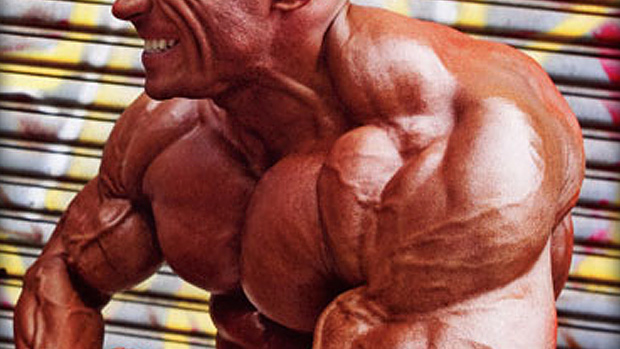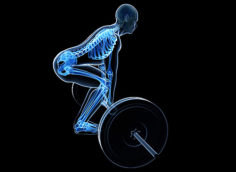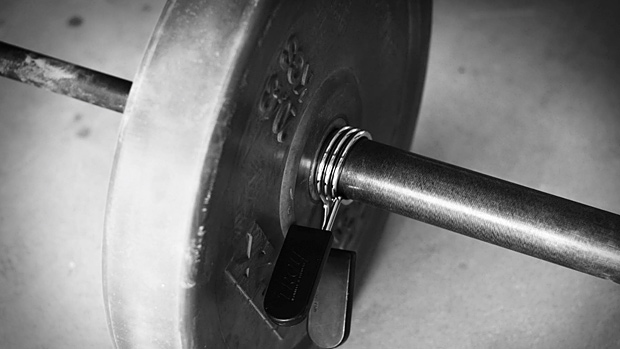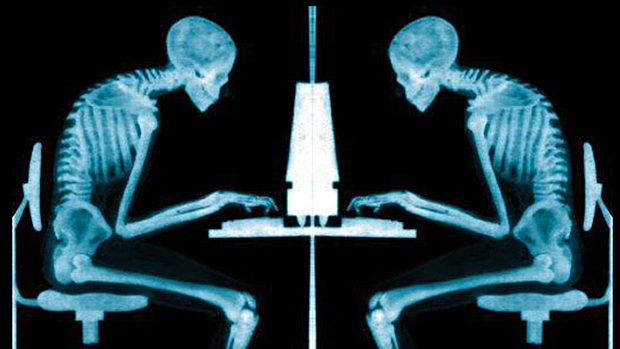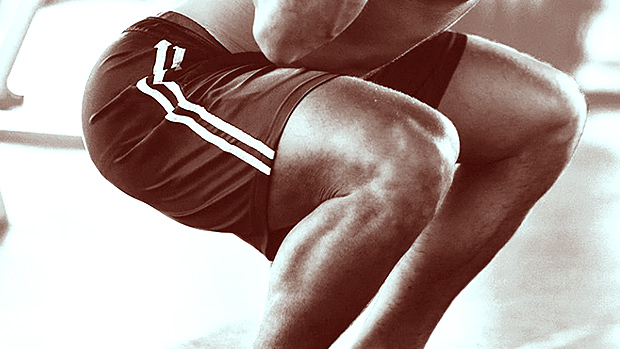Increasing numbers of trainees are starting to catch on to what savvy strength coaches have known for years: that managing nervous system fatigue is crucial to fostering long-term gains.
This newfound appreciation has led to athletes scouring their training logs, trying to figure out if their CNS is still daisy-fresh or already spiraling downward into a burnout on par with Lindsay Lohan's career.
But how much further along do you think you would be if you had known exactly when a workout was no longer productive? Wouldn't it be nice to have a system that told you precisely when you should put down the bar and call it a day?
mc schraefel just might have the answer. (And no the lower case letters on her names aren't typos; that's the way she spells her name.) dr schraefel is a researcher in Human Factors and Functional Movement Specialist and also holds numerous training certifications. She assesses athletes, coaches them one on one, and conducts workshops all in the name of better performance and enhanced quality of life.
If you'd like to start preventing bad workouts before they happen, then read on.
— Bryan Krahn
Many aspiring muscle-heads spend considerable time planning and recording workouts to optimize results.
As noble an endeavor as this is, two fundamental flaws persist: One, it takes weeks, even months, to see if what they've done is optimally effective; and two, the muscle-exclusive approach to a workout may miss some really easy ways to bring the rest of the body's systems onboard to help performance.
To have a successful, result-producing workout, you have to go beyond the basic loading parameters like sets, reps, and load. Yet unfortunately, that is where many trainees devote most of their attention, without giving the all-powerful nervous system a second thought. It's a shame really, as results often skyrocket once trainees get in tune with what really governs performance.
In this article, we're going to look at a few simple ways you can dramatically improve the effectiveness of your workout:
• What simple checks you can do right in the gym to provide immediate feedback about the quality of the workout and dial in performance.
• A quick and easy check for the previously thought-to-be-impossible-to-detect fatigue, and show you an easy way to find out which of several possible exercises is your best bet today.
• Two equally fast checks to help bring more of the body's sensory-motor system on board to increase the musculo-skeletal performance.
These are checks anyone can run today, right now, from their first step into the gym. They will make your workouts better, more productive, and you'll see results faster, guaranteed.
Let's get started!

Personal Fatigue Level: Pre and Post Sets
It's widely accepted that trying to lift in a fatigued state is never a good idea.
Rep quality goes down, and the risk of overreaching or worse, overtraining goes up. Say you're heading to the gym for a heavy day workout and you want to work hard enough to make gains without going so far as to compromise recovery. Here's a simple way to check how you're doing, to know when you can keep going and when to say enough.
BASELINE: At the start of the work out, when you get to the gym, balance on one foot, get stable, then turn your head quickly to the left; rebalance, and then quickly turn your head to the right. Rebalance as needed. A slow turn of the head won't cut it; snap your head around to the given direction to get the inner ear balance system working.
Try this with each foot. Which is your less stable foot? If you lose your balance, that's okay, the point is to be aware of what your normal balance response is on either foot with those head shifts.
If being on the left foot and looking fast to the right caused you the most challenge, like having to bend far over to one side to recover, but you still kept your footing, remember that. That's a benchmark for that side. What do you remember about your more stable side? Only a slight wobble and only looking to the left, otherwise stable? Remember that, too.
TEST: During your work out, let's say you're wondering if you should do that next set of deadlifts. It's written down that you're supposed to do that set, but you're feeling a little iffy. When you finish the current set, do your balance check with your least stable foot. How's your stability? If it's worse right after the set than when you first got to the gym, that's okay.
But if after your normal recovery period for your set it's still worse than when you got to the gym, then doing that next set isn't a good idea; your nervous system hasn't recovered, and indeed, you may be done for the day.
If you haven't recovered fully after a five-minute break; in other words, your balance is all over the place, or at least worse than when you got to the gym, it may be worth bagging the rest of your workout. If you really want to reinforce that decision, check your more stable leg too. You may be surprised at how it's now behaving.
Choosing Which Exercise from a Range of Possibilities
Say on leg day you have a choice between Bulgarian squat, single leg deads, or side lunges. Which should you do? A range of motion check can give us a good indication of which your body feels better about performing.
BASELINE: Before trying any of these leg exercises, do a baseline check. This time we'll use range of motion.
See how far your current toe touch is. Note how far your fingers are above or on the ground; how smooth or stiff is that toe touch?
TEST: Next, do one rep of the Bulgarian squats, retest the toe touch: is that toe touch easier and deeper, or harder and shallower? If it's shallower or harder, then perhaps Bulgarians are not a great choice. Try the lunge, and retest; try the single leg dead and retest. Which one works better for a deeper, easier toe touch? Go with the one that gives the best results, for smoothness/depth.
Reality Check: Now some folks may reasonably ask: Aren't we always going to test better on the last move we do because we'll be progressively warmed up/stretched? That's a really good point, but the answer is, not if the nervous system feels unsafe with a move.
If in doubt, you can perform this toe-touch test with a very similar exercise pair such as chin-ups and pull-ups. The nervous system responds quickly and immediately to anything it perceives as a threat to it, and if a particular move triggers a problem, it will shut down the body from being able to get full power into that effort. (More on this at the conclusion of the article.)
What's Holding Us Back: Sensory-Motor Integration to Improve Performance
Sometimes, we may feel like we hit a plateau in our training. We just can't lift heavier weight or get that extra rep. At such times, checking in with our sensory-motor system can help give us a performance boost.

Proprioception Integration Check—Shoe Test with Military press:
If you tend to workout in running shoes, and do up your laces on the snug side, the results of this test may be interesting.
BASELINE: Do up your shoes as snug as usual. Now do your toe touch. Check your range of motion (ROM): where are your fingers in relation to the ground? Now try a simple military press with a weight that is challenging but manageable. How'd that feel?
TEST: Now loosen your laces, or even better, take your shoes off; do some ankle circles both directions, gently roll on either side of the ankle (keep your hand on a wall while doing these mobilizations so that this doesn't become a balance challenge; it's just moving some joints). Take a few steps back and forth.
First check your toe touch. How is it? Then, try the press. Smoother? Lighter?
With most people, letting the 24% of our joints that are in the feet move more freely, and thereby increasing information to the brain, improves performance. For folks where the opposite was true and performance worsens, that's interesting information as well and suggests (usually) that there is some restriction or imbalance or pain somewhere that having that immobilization (the tight laces) works better.
That's usually a sign to get some attention so that you can move more naturally, effectively, without compromising the action of other parts of our body to do so.

Connecting the Visual System with Immediate Performance Smoothing
Do you hate ball sports? Many lifters apparently do. Sometimes it's because they never found trying to catch or kick a ball a joy, and for some, it's because of issues with vision.
Vision is the primary way we're designed to experience the world. Vision is not just eyesight or image clarity alone, but also visually guided motor performance along with the ability to interpret and make decisions about visual input.
Vision (not just eye sight) can have a huge impact on performance and by working with that sense, we can enhance performance accordingly.
For instance, here's a drill that helps both eyes work together more precisely. It's called a pencil push-up.
BASELINE: Again, before starting do a toe touch & a military press. Note the range of motion of the toe touch. Note also how the press feels.
TEST: Take a pencil, pointy end up. Focusing on the point, hold the pencil at arm's length, and then bring it back towards the tip of your nose. The goal here is to keep the pencil tip in focus for the whole length of the trip to the face, without splitting into two or without going out of view.
Stop where the image either first splits or disappears from view; the goal is to get the tip to within about an inch of the nose. (Be careful as these drills can cause discomfort in the eyes if you're not used to working the eye muscles through their range of motion.)
Now retest with the movements you just did: toe touch, press. Is the ROM deeper? Shallower? Move harder or easier? Better or worse?
If the press is harder, here's a revision of the movement: this time, we'll do one eye at a time, and then join up. Start with the pencil in the RIGHT hand, close the RIGHT eye, and line the pencil up at arms length with the right side, so the left eye will be looking over to the right.
Bring the pencil in towards the eye, keeping the left eye on it, and then when it starts to go out of view on the right, bring it over to the nose. Repeat the set up with the left arm, left eye closed, towards the left side, then to nose. Then try the both-eyes drill again. Now retest with the same movements as from the previous test: Easier press? Harder? No difference?
RESULTS: For folks where there's no difference in any of the versions of the drill, that's super: this visual skill may be working perfectly with the rest of your sensory motor coordination. If there's an improvement, however, this kind of vision work may be something to incorporate into your daily practice.
If your performance got worse, that also suggests that there's something going on that the visual system is not enjoying, and that may be a sign to check in with a sports vision therapist.

Putting It All Together
These four quick tests/drills can be used at any time in any workout to:
- Check with the balance/vestibular system to see if you're too fatigued to do another set, or even continue a workout
- Check which exercise is the optimal selection for you right now (it may change later today)
- Check joint mobility (like loosening laces, doing mobility work) to dial in proprioceptive performance
- Check visual tracking to help assess and enhance how well our primary sense, vision, is working with the rest of our performance
You might be thinking, so why do these tests work?The answer is quite simply, that the nervous system is always on, and always responding immediately.
Each of these tests provides immediate feedback about decreases or improvements in performance, and that's because these assessments work with the nervous system. The nervous system is very basic and precognitive; it's asking one binary question: threat or no threat. The answer to that question can happen very quickly.
For instance, proprioceptive nervous responses from mechanoreceptors (detection of movement) happen at about 300mph, so changes to enable more joints to move to provide clearer proprioceptive feedback, like loosening our shoes, moving our wrists, circling our shoulders through a complete range of motion, such as dynamic mobility work can be immediately beneficial.
While we may be more familiar with joint movement in a workout context, we can see from these tests that working with vision and balance can also provide great feedback, as well as help tune in our sensory-motor system to support our performance.
The balance test is a particularly good example of tuning because balance is a precognitive act: the brain doesn't have to think about it. We balance or we don't. This test is therefore more rigorous, than say the toe touch, where we can hold back or push it voluntarily. It's far harder to fake not falling over.
The Final Word: Enhancing Sensory-Motor Performance
Practice benefits the sensory-motor system just like practice benefits a lift: so practicing joint movement for each range of motion of a joint, practicing visual acuity like the pencil test, or balancing against a challenge of a rapid head move, are all great ways to practice sensory-motor skills to enhance performance of the musculo-skeletal system, immediately.
Get position, vision, and balance working and immediately we lift faster, stronger, and longer.
Better performance, better workout. Better workout, better results.
References and Related Resources
Cobb, E, Pincus, R. (2003) The SPEAR System and Converting Flinch Response. Law and Order, Oct. 1, 2003
Cobb, E, Mauck, K, Mauck, S. (2009) The Complete Athlete, Vol. 1, (DVD) Z-Health Performance Solutions, AZ, USA.
Cobb, E, Mauck, K, Mauck, S. (2010) The Essentials of Elite Performance (DVD Mini-Course)
Deliagina, T. (2006) Neural Bases of Postural Control. Physiology, 21(3), 216-225. DOI: 10.1152/physiol.00001.2006
Erickson, G.B. (2007) Sports Vision: Vision Care for the Enhancement of Sports Performance. US: Butterworth-Heinemann, 2007.
Glass, Adam T, Nelson, Brad (2010) Grip N Rip II (DVD) .
Gray, L. Chapter 10: "Vestibular System: Structure and Function of the Vestibular System: The Semicircular Ducts," Neuroscience Online, U. of Texas Medical School, Houston 1997-present,
LeDoux, J. The Emotional Brain: The Mystserious Underpinnings of Emotional Life, NY: Simon & Schuster, 1stEd., 1998.
Ohman, A. (2005). The role of the amygdala in human fear: Automatic detection of threat. Psychoneuroendocrinology, 30 (10), 953-958 DOI: 10.1016/j.psyneuen.2005.03.019.
Ostry DJ, Darainy M, Mattar AA, Wong J, & Gribble PL. (2010) Somatosensory plasticity and motor learning. The Journal of neuroscience : the official journal of the Society for Neuroscience, 30(15), 5384-93. PMID: 20392960
Pinsault, Nicolas. (2008-10-29) Differential postural effects of plantar—flexor muscle fatigue under normal, altered and improved vestibular and neck somatosensory conditions. Experimental Brain Research, 431(1), 206-107. DOI: 10.1007/s00221-008-1500-z
Purves, Dale; Augustine, George J.; Fitzpatrick, David; Katz, Lawrence C.; LaMantia, Anthony-Samuel; McNamara, James O.; Williams, S. Mark. (2001) "The Sematosensory System: Mechanoreceptors Specialized for Proprioception" Neruoscience. Sunderland (MA): Sinauer Associates, Inc.; c2001
Riemann BL, & Lephart SM. (2002) The Sensorimotor System, Part II: The Role of Proprioception in Motor Control and Functional Joint Stability. Journal of athletic training, 37(1), 80-84. PMID: 16558671
Shugart, Chris. (2006) "DJM Training " T-Muscle, 06-30-06 20:16.
Yang JF, & Scholz JP. (2005) Learning a throwing task is associated with differential changes in the use of motor abundance. Experimental brain research. Experimentelle Hirnforschung. Experimentation cerebrale, 163(2), 137-58. PMID: 15657698

